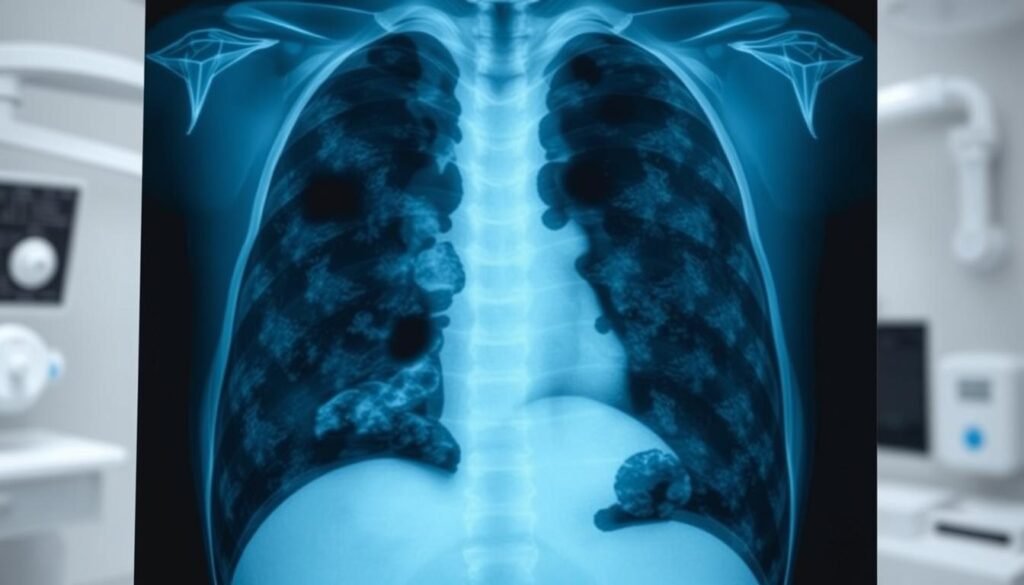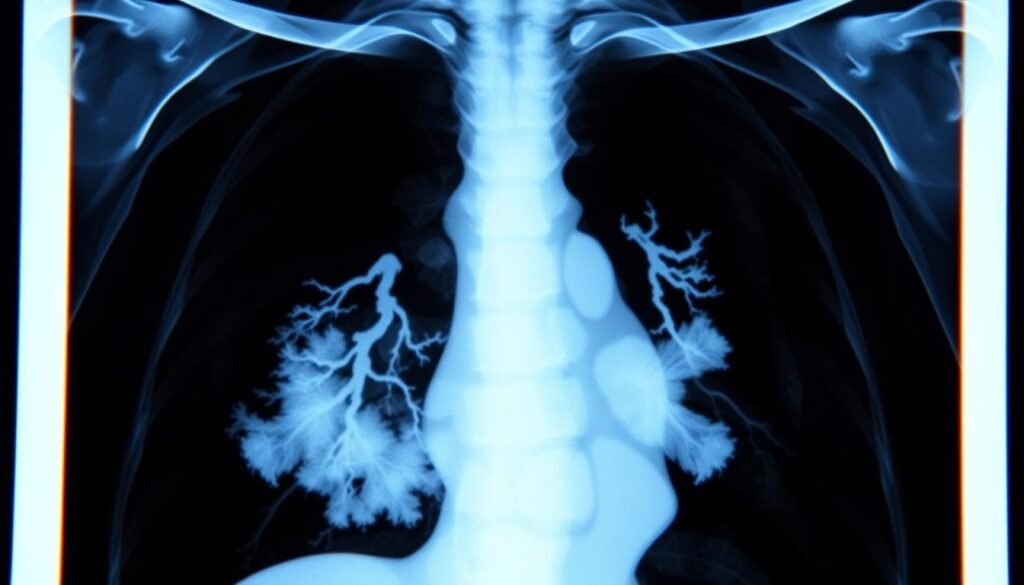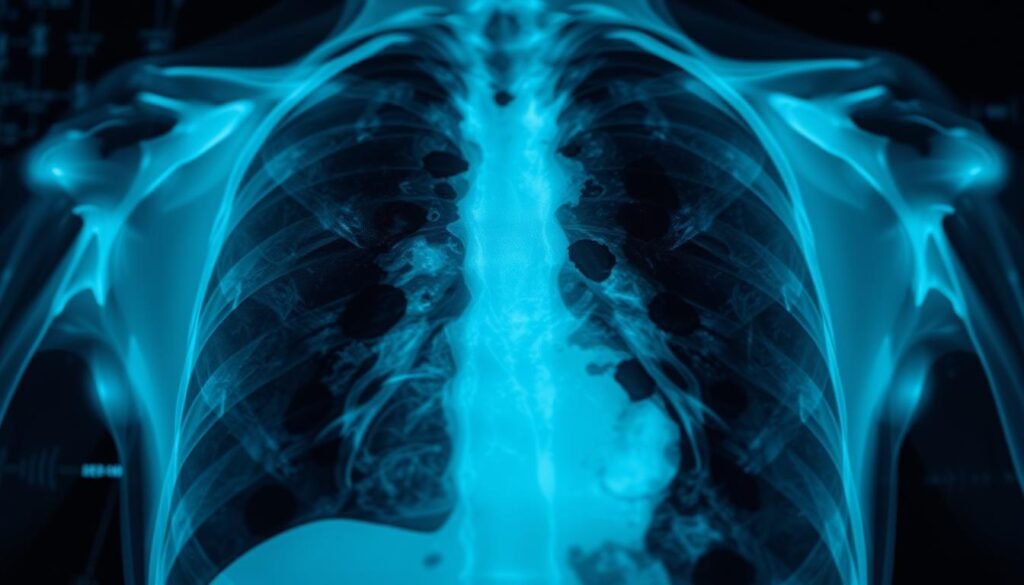Did you know between 20% to 23% of chest X-rays miss lung cancer signs? This fact points out how hard early detection can be. Lung cancer is the second most common cancer and leads in cancer deaths in the United States. Knowing if a chest X-ray can spot lung cancer is key for early action.
Lung tumors can grow twice their size in about 136 days. Early detection can make a big difference. This is because the options for surgery become limited as the cancer grows.
Early detection with tools like chest x-ray lung cancer screening is very important. Diagnosis often misses in the upper lungs where it’s hard to see tumors. It’s vital for doctors to use various tools to increase the chance of finding lung cancer early. This article will talk about what chest X-rays can and can’t do. It will also look at more effective methods in detecting lung cancer.
Key Takeaways
- Lung cancer is the leading cause of cancer deaths in the United States.
- 20% to 23% of chest X-rays fail to detect lung cancer symptoms.
- Early detection through imaging can dramatically improve treatment outcomes.
- Chest X-rays often miss small tumors (less than 1.5 cm).
- Low-dose CT scans are recommended for high-risk individuals over traditional chest X-rays.
Understanding the Basics of Chest X-Rays
Chest X-rays are a key tool for doctors. They help see the inside of the chest without surgery. They can spot problems with the lungs, heart, and nearby areas. Doctors often use them first to check for lung issues, like lung nodules or masses.
What is a Chest X-Ray?
A chest X-ray uses a bit of radiation to get pictures of the inside of the chest. It shows the lungs, heart, bronchi, aorta, and arteries. These pictures help doctors find and assess conditions like pneumonia or tumors.
How X-Rays Work in Imaging the Lungs
X-rays work by how much radiation parts of the body absorb. Bones are dense, so they look white on X-rays. Air spaces are dark. This helps find nodules and other issues in the lungs. Patients might need to stand still or hold their breath for clear images.
Benefits of Using Chest X-Rays
Chest X-rays have several key advantages:
- They are quick and available in many places.
- They cost less than other imaging tests.
- They use less radiation, which means less risk.
- They’re good at finding infections, fluid, and tumors in the chest.
However, chest X-rays aren’t the best at finding lung cancer. They might catch only a few lung nodules. If a doctor sees something odd, more tests might be needed.
| Aspect | Chest X-Ray | CT Scan |
|---|---|---|
| Radiation Dose | Low | Higher |
| Cost | Lower | Higher |
| Image Detail | Moderate | High |
| Common Findings | Lung nodules | Lung masses |
| Follow-Up | Possible | Often recommended |
Can Chest Xray Show Lung Cancer?
Chest X-rays are a key first step in spotting lung cancer early. But they aren’t perfect at finding lung tumors. Knowing when chest X-rays can reveal lung cancer helps both patients and healthcare workers.
Limitations of Chest X-Rays in Detecting Lung Cancer
Chest X-rays can’t always confirm lung cancer. Tumor size and stage affect their visibility. Tumors under 20 mm across may not show up, missing early-stage cancers.
Also, it’s easy to misread signs of lung cancer on X-rays. About 45% of chest X-rays are read by non-specialists, increasing errors.
When Chest X-Rays May Detect Lung Tumors
When tumors grow large, chest X-rays are more likely to spot them. This is more common in later stages of lung cancer. Shadows or large masses seen need more tests, like CT scans, for a closer look.
Finding tumors with X-rays is crucial, especially if symptoms suggest more testing is needed.
| Aspect | Chest X-Ray | CT Scan |
|---|---|---|
| Average Tumor Size Detected | 20 mm | 5 mm |
| Common Use | Initial screening | Detailed diagnosis and staging |
| Risk of Misinterpretation | High | Lower |
| Non-Radiologist Interpretation Rate | 45% | N/A |
It’s important to understand X-ray’s role in lung cancer diagnosis. More detailed imaging is often needed to confirm and plan treatment properly.
Chest X-Ray vs. Other Imaging Techniques
When we look at lung cancer detection, comparing chest X-rays to new imaging methods is key. Chest X-rays are the first step in checking lung health. But, technology has given us better ways to screen.
Low-Dose CT Scans: The Preferred Screening Method
Low-dose computed tomography (LDCT) scans are now the top choice for checking for lung cancer in high-risk people. They find lung cancer better than regular X-rays. For instance, the National Lung Screening Trial showed a 20% drop in lung cancer deaths with LDCT compared to chest X-rays.
While chest X-rays catch signs of possible lung issues, LDCT shows more detail and boosts survival rates. In fact, early-stage lung cancer patients have over an 85% chance of surviving five years with LDCT.
Bronchoscopy and Lung Biopsy Comparisons
Bronchoscopy and biopsies are key for confirming lung cancer after initial detection by LDCT. These methods collect tissue from suspicious areas shown in scans. Bronchoscopy looks at the main lung areas and can biopsy with precision.
Different biopsy methods, like thoracoscopy and needle biopsy, each have benefits and risks. Even though these are more invasive than scans, accurately diagnosing lung cancer often requires using both imaging and biopsy techniques.
Chest X-Ray in Lung Cancer Screening
The role of chest x-ray lung cancer screening is crucial in health talks. Lung cancer leads to many cancer-related deaths, making early detection key. Current rules reflect top methods for finding those at risk and ensuring useful screening.
Current Screening Guidelines
The American Cancer Society supports low-dose computed tomography (LDCT) for lung cancer checks. Chest X-rays aren’t suggested for general screening now. They don’t cut death rates as well as LDCT scans do. High-risk folks, like adults 55 to 80 with a big smoking history or those who quit smoking in the last 15 years, should talk to their doctors about screening choices.
Who Should Get Screened?
Chest x-ray lung cancer screening focuses on those at high risk.
- People aged 55-80.
- Those who smoked heavily, like a pack a day for 30 years.
- Current or former smokers who quit in the past 15 years.
Early detection is crucial for these groups. They must discuss with health pros the pros and cons of different screening methods. For more on lung cancer symptoms and signs, folks can look at lung cancer screening guidelines or learn about early symptoms at monitoring early symptoms.

Interpreting Chest X-Rays for Lung Cancer Signs
It’s vital to spot lung cancer signs on chest X-rays for an accurate diagnosis. Radiologists use these images to look for cancer. But chest X-rays can sometimes be misleading, confusing lung cancer with other conditions. Knowing the typical signs and radiographic patterns of lung malignancy is key to a detailed check.
Common Signs of Lung Cancer on Chest X-Rays
Some common X-ray signs of lung cancer are:
- Lung nodules that appear as small, round shadows
- Well-defined masses indicating solid tumors
- Irregular or spiculated edges on lesions that raise suspicion
- Consolidation patterns that suggest underlying pneumonia but could indicate cancer
Radiologists report findings with great care. They note if observations are normal, unusual, or suspicious. For example, chest X-ray results can hint at when to do further tests, like sputum cytology or biopsies.
Radiographic Patterns to Look For
Spotting the right radiographic patterns of lung malignancy is critical. This helps tell lung cancer apart from other conditions. Key patterns include:
- Ground-glass opacities indicating early cancer
- Masses over 3 cm that usually mean malignancy
- Unclear outlines of structures next to each other
- Pleural effusions that might have cancer cells
About 20% of lung cancer cases aren’t detected by chest X-rays. This is especially true for tumors in the upper lobes. Knowing these limits is crucial for a full diagnosis if initial images are unclear. Catching cancer early is essential for better health outcomes. So, ongoing checks are important for those with lasting or changing symptoms.
Key Considerations for Chest Imaging
Chest radiography plays a key role in checking for lung masses and potential lung cancer. It’s essential to consider patient safety and the accuracy of diagnoses. This part covers the risks linked to radiation and the importance of experts reading x-ray results.
Risks of Radiation Exposure
Chest X-rays are crucial for spotting lung tumors, but they expose patients to radiation. Even though a chest X-ray’s radiation dose is low, getting many X-rays can add up. This increase in radiation could boost the risk of cancer over time. Modern technology has cut down on stray radiation. Yet, it’s key to tell patients about these risks, especially if they need several X-rays.
Importance of Professional Interpretation
Having experts look at chest radiography images is key for correct diagnoses and treatment plans. Trained radiologists can spot small signs of lung masses. They know how to tell if something is benign or malignant. Their expertise is crucial for detecting lung tumors x-ray effectively. Wrong interpretations can miss diagnoses or lead to unneeded treatments.

| Imaging Type | Radiation Level | Use Case |
|---|---|---|
| Chest X-Ray | Lowest | Initial examination for lung masses |
| Low-Dose CT Scan (LDCT) | Lower than standard CT | Monitoring lung nodules with lower radiation |
| PET Scan | Varies | Detect faster-growing cancer cells |
| MRI Scan | None | Evaluate spread to brain or spinal cord |
Knowing these risks and how important expert interpretation is can help with effective lung cancer checks. It also encourages patients to talk about their imaging options with their doctors.
Other Symptoms to Monitor for Lung Cancer
Knowing the symptoms of lung cancer is key for early detection and treatment. Besides chest X-rays, there are other signs that need medical attention. Watch out for a chronic cough, losing weight without trying, and coughing up blood. Spotting these signs early can lead to quicker diagnosis and treatment.
Recognizing Early Signs
Spotting lung cancer early can greatly improve treatment success. Keep an eye out for these symptoms:
- A chronic cough that doesn’t go away with treatment.
- Weight loss that happens without trying.
- Coughing up even a little blood is a red flag.
- Feeling short of breath doing everyday activities.
- Chest pain, especially when you breathe deeply or cough.
It’s crucial to watch for these symptoms, particularly if you’ve smoked or have other risk factors.
When to Consult a Healthcare Professional
If you have any of these symptoms together, see a doctor right away. Getting help early can open up more treatment options. Keep in mind:
- If your symptoms don’t improve after several weeks.
- If your overall health suddenly gets worse.
- If you or your family have a history of lung cancer.
- Knowing if you’ve been around harmful substances for a long time.
Seeing a doctor quickly can help you get a diagnosis sooner. Taking action early can improve chances of beating lung cancer.
| Symptom | Indicates Potential Lung Cancer |
|---|---|
| Chronic Cough | A cough that lingers for weeks |
| Unexplained Weight Loss | Losing weight when you’re not trying to |
| Coughing Up Blood | Seeing blood in your spit or saliva |
| Shortness of Breath | Trouble breathing during usual activities |
| Chest Pain | Pain when you breathe or cough |
Addressing Misdiagnosis and Missed Cases
Detecting lung cancer with chest X-rays is tough. It often fails to correctly spot the disease. This can really affect how well patients do.
Challenges in Lung Cancer Detection via X-Rays
There are many hurdles to finding lung cancer through X-rays. A key issue is that a lot of cases aren’t caught, which affects treatment choices. Some factors making detection hard include:
- Anatomical Overlap: Parts of the body can cover up cancer, making it tricky to see.
- Small Tumor Size: Small cancers, especially those under 10 mm, are only spotted 29% of the time.
- Interpretative Variability: Doctors can see the same X-rays differently, which can mix up diagnoses.
- Limited Sensitivity: It’s harder for X-rays to find smaller tumors, often catching them too late.
Common Misinterpretations of X-Ray Images
Wrong takes on X-ray images make finding lung cancer even harder. Mistakes mainly come from:
- Scanning Error: This causes about 30% of missed spots on lungs, often from not looking carefully enough.
- Recognition Error: Around 25% of misses happen because doctors don’t catch what’s actually there.
- Decision-Making Error: The biggest issue, causing 45% of missed cases, is when doctors make the wrong call on what they see.
Lung cancer leads to 1.59 million deaths each year. So, tackling these issues is key. Many problems with misdiagnosis end up in court, showing just how serious this is. Better training and clearer rules for reading chest X-rays could help doctors catch cancer earlier.

Exploring Advances in Thoracic Radiology
The field of thoracic radiology is evolving fast, mainly due to better lung lesion detection methods. Innovations in technology and artificial intelligence are key. They help doctors spot possible lung cancer sooner and more correctly. Thanks to these tools, people with lung cancer may have better chances of survival.
New Technologies Improving Detection
New imaging technologies have changed how lung lesions are identified. Better imaging quality makes it easier to see small changes that could be early lung cancer. Low-dose computed tomography (LDCT) is especially effective for people at high risk. It boosts cancer detection rates. Sadly, only 21% of lung cancers are found when they’re still localized. These new tools could close that gap a lot.
The Role of AI in Radiology
Artificial intelligence is now crucial in thoracic radiology. It helps create algorithms that analyze large amounts of chest X-rays quickly. This identifies suspicious areas that might show lung lesions. AI boosts the speed and accuracy of diagnoses. It not only works well with traditional methods but also improves how lung cancer is treated.
With a focus on finding cancer early, technology and AI are leading the way in thoracic radiology. These developments could mean faster treatment and better results for lung cancer patients. For more details on cancer detection, check out the latest research.
Conclusion
Knowing if a chest x-ray can detect lung cancer is key for early help and good outcomes. Chest x-rays are often the first test but they miss about 23% of lung cancers. They are better at spotting big tumors but struggle with very small ones, under 1.5 cm.
It’s important to know the symptoms like unexpected coughing up blood. This needs fast doctor visits, no matter what the x-ray says. People who smoked and are between 55 to 74 should get regular checks. These checks can find lung problems early and improve chances.
New tech is helping doctors find lung cancer better, giving patients the best care. Even though chest x-rays are a starting point, we need more tests if there are odd signs or symptoms. Making diagnosis better can help save lives.